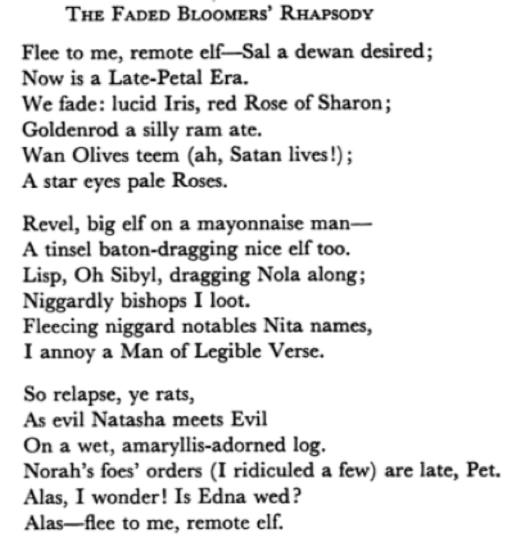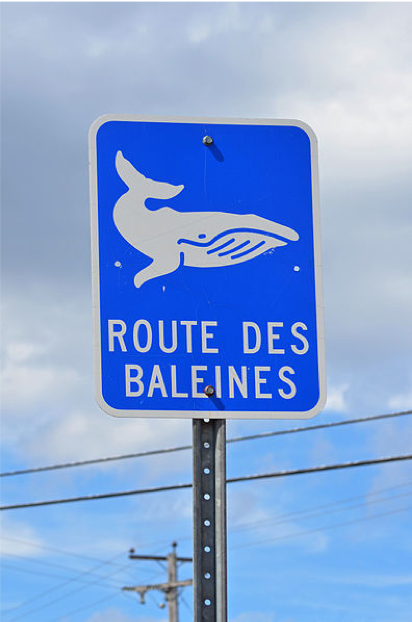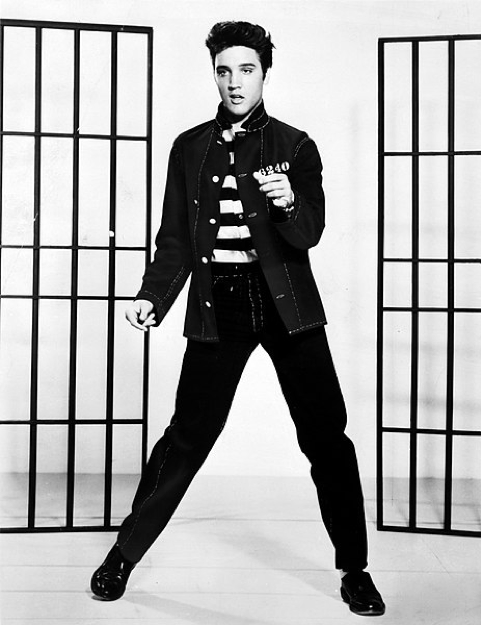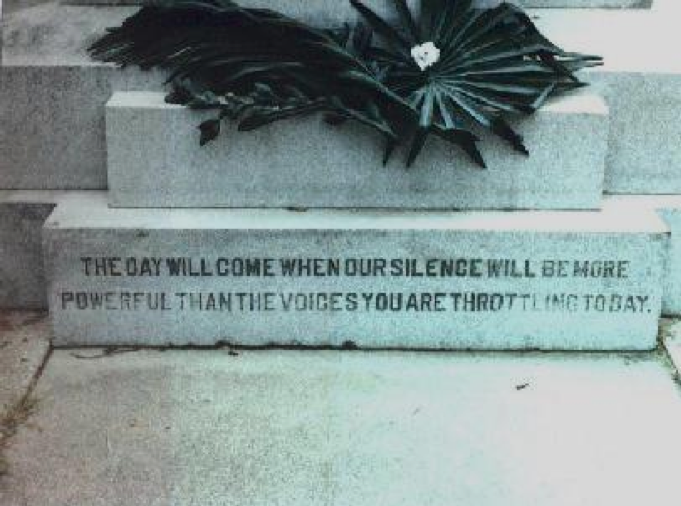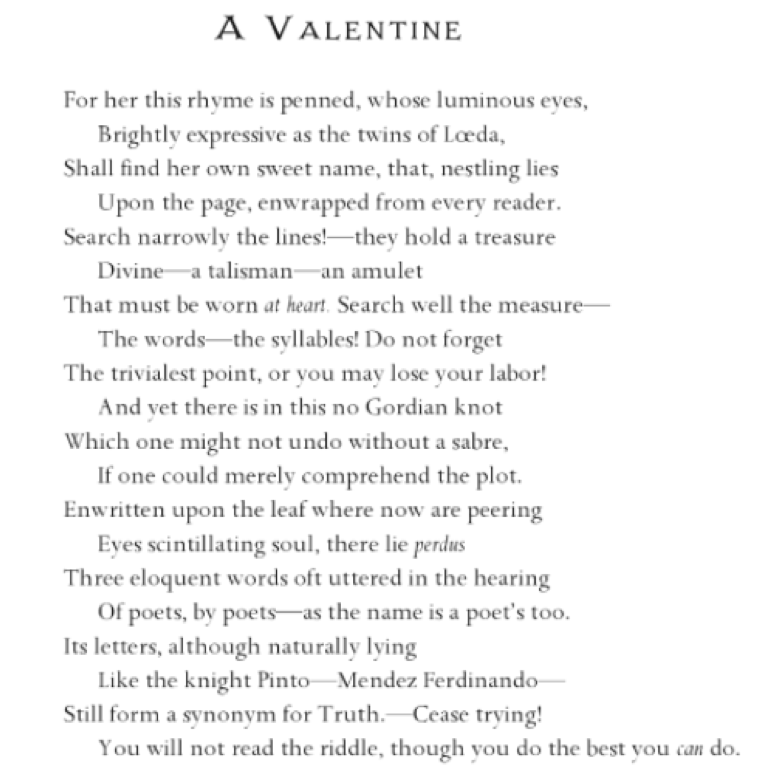LIBRARY BLOG
Poetic Forms
Not all poetry has to be pretentious
Poetry dredges up images of Shakespearean sonnets and meanings you can never quite fully understand. What is iambic pentameter, and why does it matter? Is this dude talking about a woman or an actual flower? Don’t be alarmed! You can still enjoy poetry even when you’re not fluent in Old English and symbolism. Poetry can be fun and light, too! Here’s a list of some pretty neat poetic forms—some you may know of, and some you may not!
Concrete Poems and Calligrams
These can be called a whole slew of names—emblematic poems, figured poems, visual poems, and many, many more. Now depending on which source you go to, concrete poems and calligrams are either listed as the same form or separated into two. Both have to do with how the text is presented, not necessarily about the rhyme, meter, syllables, etc. that can make poetry tricky to learn. Concrete poems are verses that are presented in a shape that represents the poem itself in order to further convey the message. Take the verse “Easter Wings” by George Herbert for an example. The poem is presented in such a way that it resembles wings.
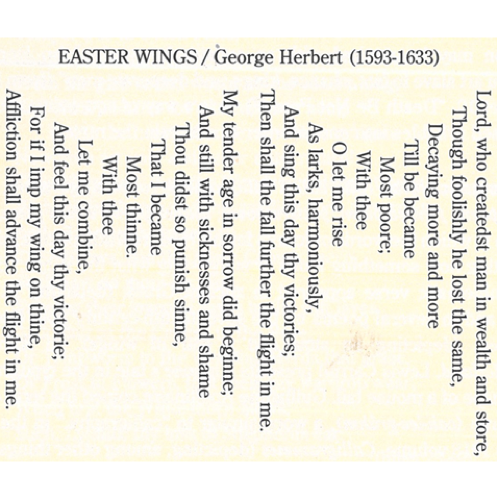
“Easter Wings” by Herbert is formatted specifically to appear as a pair of wings.
Source: The Poetry Dictionary, John Drury, 1995
A calligram is a verse where the text of the poem forms an outline of an image or a complete image of something related to the poem. [1] The French children’s song (yes! nursery rhymes and songs are poems, too!) “Jean de la Lune” (translated to “John of the Moon”) was made into a calligram depicting a man with a crescent-shaped head standing on the moon and looking out to Earth. Every detail of the image is comprised of the words of the song.
Found Poems
Found poetry is a quite literal name for this form. You find a poem. It’s cool! The poet takes a text like a newspaper article, a page from a textbook, or a spread from a magazine and uses the words within to create a poem by a.) blacking out the text except the desired words or b.) cutting the desired words out of the text entirely and placing them out of context of their source. [1] How the new poem is presented depends on the poet. Let’s say you have a found poem. You can have it be written down like a traditional poem. You can get crafty and cut out the words from the original source and paste them to another surface. You can keep it with the covered text of its original. Or something completely different. It’s up to you! This is a pretty modern form. The term was used for the first time in 1966, but the concept might have been around for longer. [2]
Haiku Poems
The haiku hails from Japan. In its traditional 17th century form, the poem is a three-line verse containing 17 syllables total following a 5-7-5 syllable pattern. The brief poem evokes the theme of nature and seasons, even if it’s not explicitly written. Sometimes, it’s only the intention of conveying a season and brevity that matters in haiku, not the number of syllables, so don’t be shocked to see some famous haiku (surprisingly, the plural is not “haikus”) that are less than 17 syllables and 3 lines. [1] The English haiku, however, follows looser guidelines. There’s less of an emphasis on the theme of nature, making it a free-range type of poem. [3] Because of this open-endedness, there’s much more room for all sorts of creativity. Social media has certainly had a hand in making the haiku a commonly known poem, producing verses that are more humorous than serious. An example of a more serious haiku is “The Old Pond” by Matsuo Bashō. If you want a humorous example—remember when “Haikus are easy / But sometimes they don’t make sense / Refrigerator” was circling around the internet? Boom. Haiku.

English translation of “Old Pond” by Matsuo Bashō, published in 1686.
Nonsense Poems
Yes, this is a poem that you’re not supposed to fully understand. They exist! This is a primarily children-oriented poetic form that is purposefully riddled with paradoxes, fantasy elements, made-up language, and humor that add up to the poem being… Well, nonsensical. A famous example of a nonsense poem is “Jabberwocky” by Lewis Carroll which begins with the lines “’Twas brillig, and the slithy toves / Did gyre and gimble in the wabe: / All mimsy were the borogoves, / And the mome raths outgrabe.” [4] Did you get all that? Neither did I. Good poem though!
Palindrome Poems
Tough to write but incredibly cool to read, palindrome poems can be read forwards (from the first letter of the first line to the last letter of the last line) and backwards (from the last letter of the last line to the first letter of the first line) the same way. They hark all the way back to the 3rd century BCE and may have been invented by the satirist and poet Sotades of Maroneia. [5] Single words like “kayak” or short phrases like “top spot” are palindromes, but some people task themselves to make whole poems like this. Not just three-line haiku either. I’m talking several stanza-long poems.
A second kind of palindrome poetry exists, however! More aptly called a mirrored poem in some sources, this type is more concerned with words than letters. Instead of the poem reading the same from the first letter to the last letter and reverse, this second type reads the same from the first word to the last word and back the same way. The top half of the poem is reversed in the second half of the poem. The middle line is a single word, making the verse look—surprise, surprise—like it’s been mirrored. [6]
In this palindrome poem by Howard W. Bergerson, a palindromic phrase (“Flee to me, remote elf”) begins and ends the poem, but the palindrome just keeps going after that! “The Faded Bloomers’ Rhapsody” can be read forwards and backwards as the same poem.
Epic Poems
This is one of the oldest poetic forms around today! An epic is a long (like novel-length) poem that chronicles the stories in a group’s mythology. They originate back in the time of the oral tradition, when stories were performed aloud to an audience without being written down beforehand. The poet would memorize the narrative, making subtle changes like adding and deleting lines where they saw fit. If they forgot a part, they would improvise. No two poets told the tale exactly alike, even when one learned the story from the other. Through all this altering, the tale would slowly be morphed into the story that would eventually be written down as text became popularized. Remember when you read The Odyssey in high school? That’s not the same version of Odysseus’s journey that a bard would have told to his pals in Ancient Greece. Not only is there the problem of translating the Greek to English, but when the epic was first written, all the changed details meant that whole chunks of the original narrative were lost forever.
Scholars believe that the first epic was written as early as 2500 BCE, but modern epics (like Pablo Naruta’s Canto General) that emphasize 21st century problems and experiences are being written today! [1]
Giuseppe Bottani’s vision of the goddess Athena showing Odysseus the land of Ithica in the epic poem The Odyssey.
Kennings/Epithets
Alright, so these aren’t poetic forms, but they’re a type of poetic language that we use every day without realizing! A kenning is a clever way to say a single noun as a phrase. It’s like a nickname of sorts. They’re a figure of speech. Metaphors (comparisons of two unlike things [7]) or metonyms [1] (where something is represented by something else that is closely associated with it [8]) are commonly used in kennings. A metonym would be like saying “The White House” when referring to the president. Thus, “The White House” would be a kenning for the sitting president. To be a kenning, the word being substituted cannot also be in the phrase. If you describe a hole in the street as a “pothole,” you haven’t used a kenning. You have the metaphor of it being as deep as a pot, but “hole” has been reused. Not a kenning!
Kennings were quite popular in the epics and other verses of Old English and related Germanic languages. [1] For instance, poets would write “storm of swords” instead of battle or “blood-bringer” instead of warrior.
While kennings are Norse in origin, epithets are Greek. Similar to kennings, epithets are also a way to say one word as several, but the distinction lies in that an epithet was more for syllabic patterns. When a poem (again, like an epic) needed more or less syllables in a line, an epithet would be employed to preserve the pattern. For example, an epic poet might use “Grey Eyes” as a two-syllable way to say the three-syllable name “Athena” when his line needed one less syllable. [1] Keep in mind that this would have been during a time where the Olympian gods and goddesses’ physical appearances were as important to the population as their powers. Knowing that “Grey Eyes” is Athena would be an immediate realization. Think about it with a modern-day context. When someone uses the epithet “The King of Pop” to tell you who their favorite musician is, you automatically know they’re talking about Michael Jackson.
Let’s look at some more epithets. Unlike a kenning, epithets are not always metaphorical or even a figure of speech at all, like “the Great” in “Alexander the Great.” During his reign he was… you know, great. Sometimes a person’s achievements or background are mixed with a metaphor, hyperbole, or another figure of speech to create an epithet (see “The King of Pop” again). In its traditional sense, epithets were mainly used for people, but objects and places can have an epithet, too, like calling New York “Empire City.” Today, there doesn’t have to be a focus on syllable addition or subtraction to make an epithet.
Clerihew Poems
Here’s a quite niche, often overlooked poem thats only purpose is to say something funny or mean about a well-known person. A Clerihew is a four-line poem that follows an AABB rhyme scheme (where the final words of the first two lines rhyme and the final words of the last two lines rhyme). The first line identifies who you’re writing about—usually a celebrity or some other prolific figure. The second line says something funny about the subject. The third and fourth lines, then, riff off a fact or fantastical aspect about the subject.
Fun Fact: The Clerihew was invented by 16-year-old Edmund Clerihew Bently when he was a student in 1890. [1] He would’ve thrived in today’s roast culture. Here’s the first Clerihew ever, written by the big man himself:
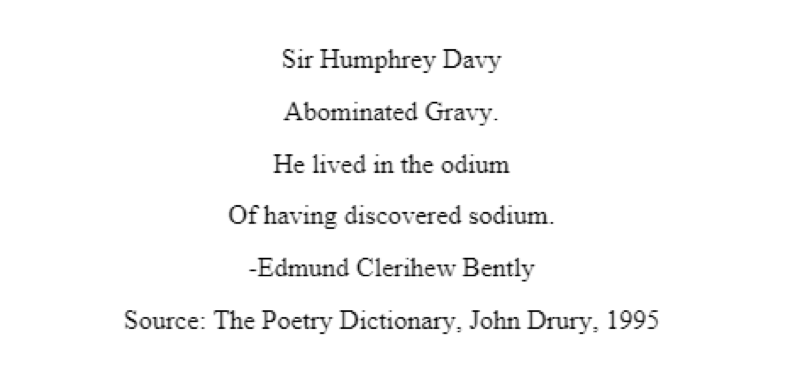
Golden Shovels Poems
A very new poetic form! They’re not about gardening tools, either. The golden shovel form was invented by Terrance Hayes in 2010. His poem, “The Golden Shovel” started as a way to honor another poet—Gwendolyn Brooks. In a golden shovel, the writer takes a source poem and ends each line of their poem with each consecutive word of the source poem. As an easier way of explaining that, if you read the last words of each line of Hayes’s “The Golden Shovel,” you’ll be reading “We Real Cool” by Brooks, hidden in the midst of an entirely new poem! [9]
Epitaphs
Another Greek contender! Not to be confused with epithets, epitaphs are short verses on graves or tombs that honor a deceased individual or group. They’re essentially elegies squeezed into a handful of lines. It’s easy to forget that epitaphs are a poetic form, as “epitaph” in current day can also mean any inscription on a gravestone—even names, birth dates, death dates, and descriptions. When we’re talking about the poetic form, however, epitaphs have to be concise and powerfully expressive. Therefore, names and dates alone aren’t epitaphs in the poetic sense. [1]
Free Verse
Free verse poetry doesn’t want to stress you out with syllable counts and making sure you’re writing in iambic pentameter. Free verse poetry just wants you to be happy. Perhaps one of the most creative forms, this type of poem gives all the power to the poet. There are no steadfast rules to formatting, rhyme schemes, syllable patterns, tone, subject, or language. In fact, it’s almost expected that the poet relies on line breaks to build a poem’s rhythm instead of anything else. This type was popular during the 20th century. Langston Hughes is sometimes hailed as “the father of free verse” (hey look—an epithet!) because of the plethora of free verse poems he published, like the famous “I, Too.” [10]
Acrostic Poems
This is the last Greek poem, but only because this is last entry on this list. The Greeks just really loved art and literature, okay? This one has roots in Greek mythology. One of the Sibylline Oracles gave her prophecies in the form of acrostics. The poetic form was used as early as 2nd century BCE. [11] An acrostic is a poem that spells out a word—like a name—in descending letters. Like with free verses, there’s no strict rhyme or meter. Most commonly, the word is spelled out with the first letters of each line, but there’s other ways to hide words in your acrostic. Edgar Allan Poe, for instance, wrote a love poem— “A Valentine”—to a married woman. Instead of stating her name outright, he encoded her name in the verse by making the letters of her name reflect a place in the poem. The first letter of her name became the first letter of the first line, the second letter of her name became the second letter of the second line, and so on, creating a staircase-like effect in the poem. [12] Don’t worry—I went through and figured it out for you. Poe’s secret love was named Frances Sargent Osgood.
Interested in writing poetry?
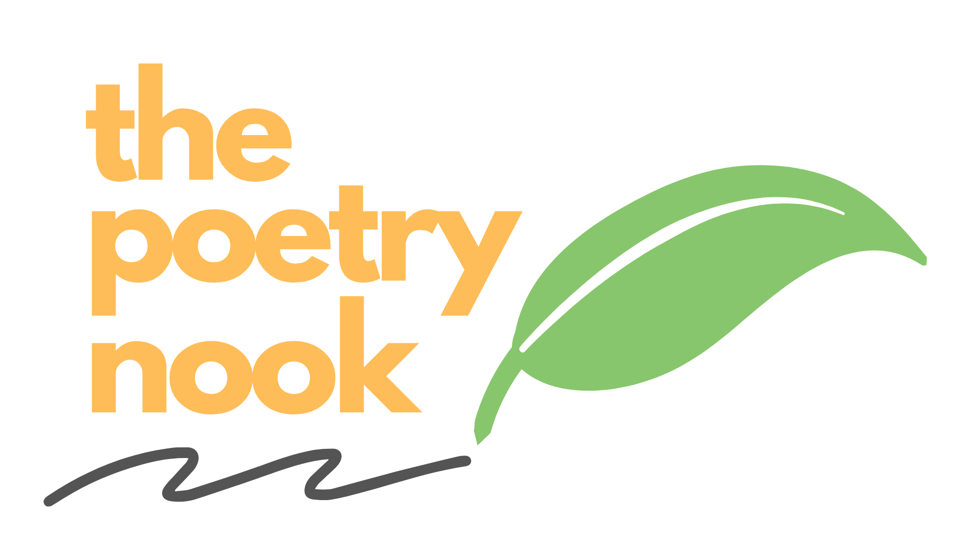
Keep an eye out in September for the new monthly blog, The Poetry Nook. Each new entry will be chock full of poetic history and lore, favorite lines and scribes, and writing prompts to get your imagination running. So, pour your cup of tea, sharpen your quill, and get to writing.
Resources
1. The Poetry Dictionary, John Drury, 1995
2. The Definition of “Found Poem”
3. (A History of) Poetry, J. D. O’Hara, 1975
4. Gale eBooks: Nonsense Verse
5. Palindromes and Anagrams, Howard W. Bergerson, 1973
6. Poetry Slam Bam Thank You Ma’am, Brandy Noelle Souza, 2015
7. The Definition of “Metaphor”
8. The Definition of “Metonym”
9. Gale eBooks: We Real Cool
10. Gale eBooks: I, Too
11. Gale eBooks: Acrostic
12. Gale eBooks: Some Basic Poetic Forms
Lillian, Reference Department




